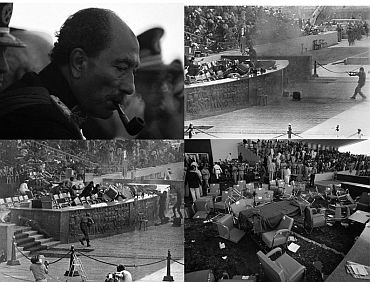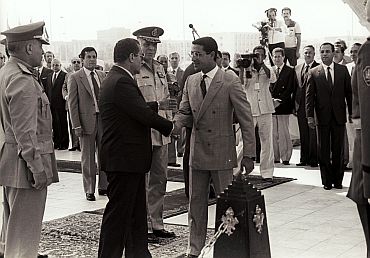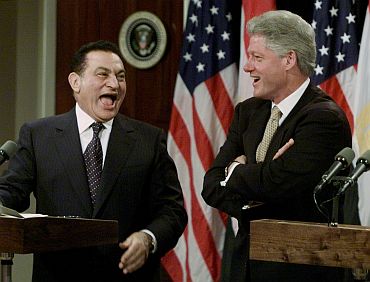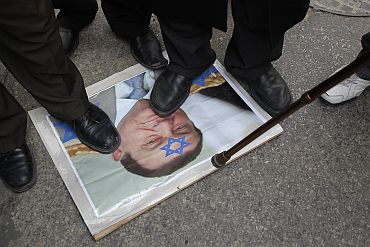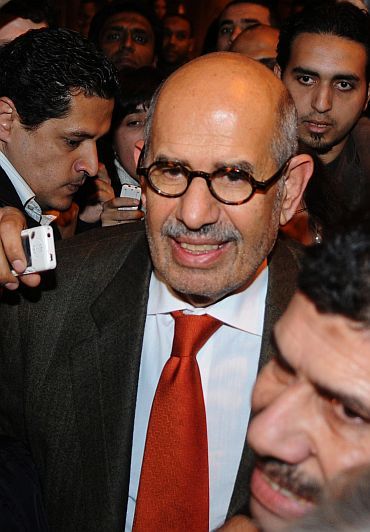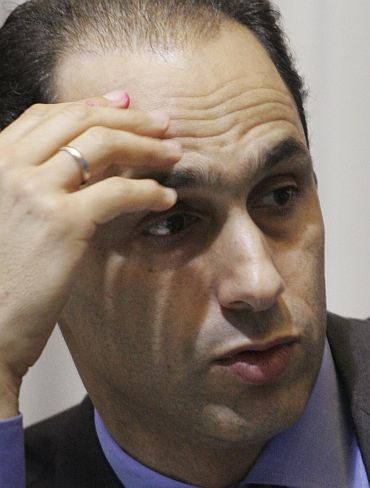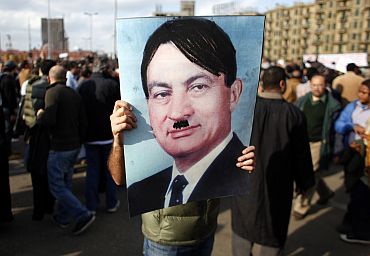 | « Back to article | Print this article |
Mubarak: From popular President to hated dictator
For 30 years, Mubarak has ruled the country that by far is the most powerful in the Arab world. And it all started on October 6, 1981. Egypt was shaken when its President Anwar Sadat was assassinated by right-wing Arab groups during a military parade before the world's eyes. Mubarak, who was then the vice president, was wounded in the attack. Terrified he stood there and by the time stunned security police began firing back, killing two of the assassins, Sadat was already dying.
Mubarak was a natural successor. He took control of the government on October 14, 1981 and has held it, by various means, ever since. While this is looked at as his first appearance on the global stage, one cannot overlook the crucial role he played in 1973.
He is still credited with winning the war that changed the course of Arab Israeli relations in October 1973, when he was Air Chief, under Sadat's presidency. The victory over Israel brought him personal glory too.
Click on NEXT to read further...
Mubarak: From popular President to hated dictator
Mubarak's political significance as vice president can be seen from the fact that at a conversation held on June 23, 1975 between Egypt Foreign Minister Fahmy and United States Ambassador Hermann Eilts, Fahmy said to Eilts that "Mubarak is, for the time being at least, likely to be a regular participant in all sensitive meetings".
He advised the ambassador not to antagonise Mubarak, as he was Sadat's personal choice.
Mubarak: From popular President to hated dictator
Mubarak may be considered largely unpopular today, but as President, he allied with the West and an anchor of stability in the Middle East. Taking over as President, he moved quickly to crush an Islamic uprising and jailed over 2,500 members of militant Islamic groups engaging in violence.
Mubarak retained most of Sadat's foreign and domestic policies, and Sadat's close ties to the United States. All the Arab states but three had criticised Egypt for the treaty with Israel, so Mubarak tried to rebuild relations with Jordan, Iraq, Saudi Arabia, and Palestine Liberation Organisation leader Yasir Arafat. It was Mubarak who encouraged Arafat to compromise and recognise Israel's right to exist.
Throughout the 1980s Mubarak increased the production of affordable housing, clothing, furniture, and medicine. He also kept a close eye on his officials, firing ministers at the first hint of wrong-doing and fining members of Parliament for unnecessary absences.
Egypt's heavy dependence on US aid and her hopes for US pressure on Israel for a Palestinian settlement continued under Mubarak. He improved relations with the former Soviet Union. In 1987, Mubarak won election to a second six-year term.
Mubarak: From popular President to hated dictator
Mubarak was angered over the 1990 Iraqi invasion of Kuwait. When the US was hunting for a military alliance to force Iraq out of Kuwait, Egypt's President joined without hesitation. After the war, his reward was that America, the Arab states of the
Persian Gulf, and Europe forgave Egypt around $14 billion of debt. He won America's support and Egypt enjoyed massive amounts of military and economic aid over the last three decades.
However, as years went by Mubarak became more authoritarian. He throttled meaningful political evolution and curbed the freedom of expression. Plots to assassinate Mubarak had surfaced in 1992, 1993, and 1995 and he is known to have survived six assasination attempts. But Mubarak continued his tough stance. His crackdown led to charges against his government of torture, threats to the press, and other human rights abuses.
Mubarak: From popular President to hated dictator
And all of this worsened in 2005. After increased domestic and international pressure for democratic reform in Egypt, Mubarak asked the largely rubber stamp Parliament on February 26, 2005 to amend the constitution to allow multi-candidate presidential elections by September 2005.
On July 28, 2005, Mubarak announced his candidacy, as he had been widely expected to do. The election which was scheduled for September 7, 2005 was widely seen as heavily rigged.
Votes were bought for Mubarak in poor suburbs and rural areas. It was also reported that thousands of illegal votes were allowed for Mubarak from citizens who were not registered to vote. On September 8, 2005, Ayman Nour, a dissident and candidate for the El-Ghad Party, contested the election results, and demanded a repeat of the election. In a move widely seen as political persecution, Nour was convicted of forgery and sentenced to five years on December 24, 2005.
Even the Muslim Brotherhood, which has a wide cadre base in Egypt, fielded candidates as independents due to their illegality as a political party. They won 88 seats to form the largest opposition bloc, but only after the arrests of hundreds of Brotherhood members.
Constitutional amendments adopted by the National Democratic Party-dominated Parliament has made it virtually impossible for independents like former IAEA chief Mohamed El-Baradei to run for president.
Mubarak: From popular President to hated dictator
Soon after, Mubarak appointed his son Gamal as the general secretary of the ruling NDP, a move that convinced many of his unwillingness to let go of power.
As Mubarak tried to tighten his grip over Egypt, anti-government protests strengthened in 2005 giving rise to the Kifaya (enough) movement, the unofficial moniker of the Egyptian Movement for Change.
It first came to public attention in the summer of 2004, and achieved a much greater profile during the 2005 constitutional referendum and presidential election campaigns. Since then it has opposed Mubarak's presidency and over the years the voices have only grown louder.
Mubarak: From popular President to hated dictator
What Egypt need was a trigger and which it found in the uprising in Tunisia. The January 14 popular revolt in Tunisia that lead to the ousting of dictator Zine al-Abidine Ben Ali led to the unrest in the region. Almost two after the topple of the first ever Arab dictator, thousands of protesters poured into the streets of Cairo and a handful of smaller Egyptian cities on January 25 to chant slogans against Mubarak and demand more rights.
Successfully breaking the taboo on directly criticising and challenging the president, the Kifaya movement joined the protests. In another boost to the stir, the Muslim Brotherhood also threw its support behind the demonstrations.
Today, Egyptians of all classes and persuasions are part of what the world calls the revolution of 2011. As most of 80 million Egyptians stand against Mubarak, 82-year-old president, now says he will go -- but only at the end of his term in September, with dignity and with a subtle threat that if he does not get his way, things could turn even uglier.
